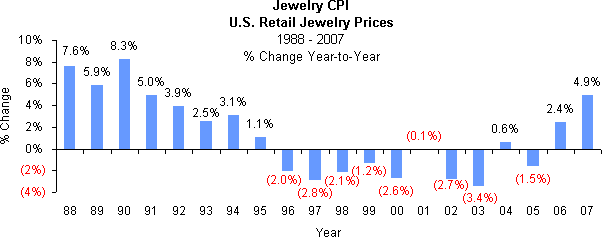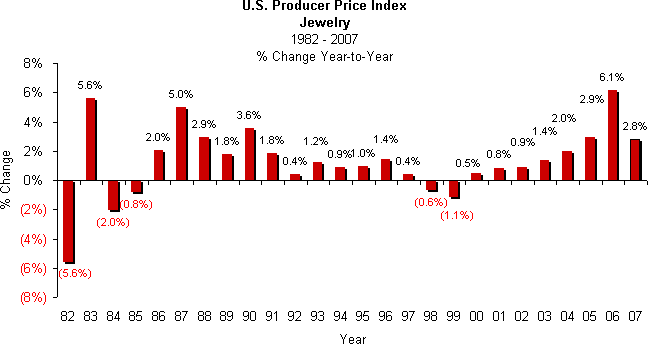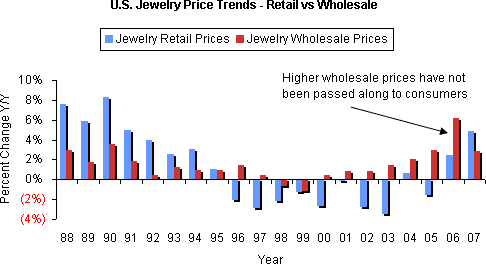IDEX Online Research’s Challenges for 2008: Cost Inflation Rages; Retail Prices Must Rise
February 07, 08
When Terry Burman, head of Sterling Jewelers’ owner Signet Group, talks about jewelry price inflation, you’d better listen. Burman, who normally plays his cards close to his vest, has said essentially that Sterling plans to raise retail prices broadly across all categories of jewelry. He further noted that some jewelry retail pieces hadn’t been re-priced in years.
He’s right, and he knows it. The numbers back him up.
All U.S. jewelers – and global merchants – need to take a look at their pricing strategy. Now that the issue of price inflation has finally come out of the closet, jewelers need to address it.
Price Deflation in U.S. Market
For nine of the past twelve years, retail prices of jewelry in the U.S. market have fallen, according to the Department of Commerce. The graph below of the U.S. Jewelry Consumer Price Index tells the story.

Source: BLS
As a result of this price deflation, jewelers’ gross margins have continued to erode. In short, merchants have been absorbing cost increases from their suppliers rather than passing them on to shoppers.
The graph below of the U.S. Jewelry Producer Price Index summarizes producer price trends for jewelry.
 Source: BLS |
When the Jewelry CPI and the Jewelry PPI are both plotted on the same graph, it becomes even clearer that jewelry retailers absorbed suppliers’ price increases.

Source: U.S. Dept. of Commerce
Why Haven’t Jewelers Passed on Cost Increases?
The easiest way to go bankrupt slowly is to let profits diminish to the point that the become losses. It slips up on too many merchants 20-30 basis points at a time. The merchants don’t realize what’s happening until it is too late.
Why haven’t retail prices risen along with producer price increases? There are several key reasons that jewelers and suppliers cite, as follows:
- Retail jewelers – and their suppliers – have been absorbing some of the price increases, rather than trying to push them downward through the distribution pipeline.
- Labor costs have declined as jewelry manufacturers have shifted production to low-labor cost regions of the world; this has helped to offset rising commodity prices.
- Manufacturers may have made design changes to reduce the amount of precious metal in an item of jewelry. For example, a manufacturer may take a ring with a solid back under the stone and remove some of the metal, leaving a “web” of metal, rather than solid metal. Thus, there is less of the commodity material in the ring, and the retail price point can be maintained, despite higher precious metal costs.
- Jewelry inventory turns at about one time per year in a specialty retail jewelry store. Thus, much of the merchandise in most jewelers’ stores is a year old. The cost of that merchandise does not reflect sharply rising commodity prices in most of 2007. For example, at the beginning of 2006, gold was just over $500 per ounce; at the beginning of 2007, it was just over $600. Today, gold is $900 per ounce. Much of the gold jewelry in merchants’ showcases was bought when gold was $600 or so. As jewelers replace this low cost gold, retail prices will rise.
- We hear the same excuse: we’d lose sales to our competitors if we raised prices. Which is worse: going bankrupt or making a smaller profit?
- No one has pricing power. Because the industry is so fragmented – there are about 26,000 jewelry retail merchants in the U.S. – no single jeweler has enough market clout to force prices higher.
With raging cost increases of precious metals, it is imperative that jewelers develop a strategy for raising prices, both at the retail and supplier level. The government’s Jewelry Producer Price Index inflation rate is running at a record high level, and the Jewelry Consumer Price Index has reached levels we haven’t seen in a couple of decades. Jewelers can’t ignore these cost increases any longer.
Will you re-price your jewelry in 2008? If you don’t, your margins will continue to decline, and you risk – at worst – bankruptcy. Now, that’s a sobering thought.
***
This article is the first in a series that expand on the points IDEX Online’s director of online research, Ken Gassman has raised in his analysis “State of the Jewelry Industry.”
Ken is available to speak to corporate management groups and others about the State of the Jewelry Industry. He has developed a PowerPoint presentation which can be customized to your group. For further information, please email Ken at research [at] idexonline [dot] com.